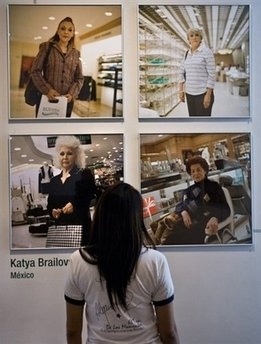
|  |  |  Vallarta Living | Art Talk | September 2008 Vallarta Living | Art Talk | September 2008  
Mexico: Traveling Photo Show Explores Global Migration
 Sophie Nicholson - Agence France-Presse Sophie Nicholson - Agence France-Presse
go to original


| | A visitor looks at pictures of the exhibition 'Laberinto de Miradas' (Labyrinth of Glances), on August 22, in Mexico City. (AFP/Ronaldo Schemidt) | | |
Mexico City - From the fear-struck eyes of a Senegalese man waiting to scale a wire fence into Europe to the blank stare of a Russian housewife in Panama, a provocative exhibition setting off from Mexico explores the many faces of one of the world's pressing issues - immigration.

The collection of photos and videos entitled "Laberinto de Miradas", or Labyrinth of Glances, will be shown in more than 20 countries over the next three years.

The ambitious project was the brainchild of Spanish photographer Claudi Carreras, who spent two years criss-crossing Latin America and Europe to go beyond the stereotyped news photos and capture the drama and deeper questions of identity facing those who leave home.

"We're all traveling in some way. It's about understanding the idea of the immigrant not only as the person in the newspaper who is trying to cross a border in a lorry," said Diego San Vicente, curator at Mexico City's Spanish Cultural Center where the show opened.

The show features one of the world's busiest border crossings - the road between Tijuana, Mexico and San Diego, California, whose snaking lines of traffic play out continuously on one video.

Another, accompanied by photos, depicts daily life in a giant squat in Sao Paulo, Brazil, which some 1,680 immigrants have made their home.

The works by Latin American, Portuguese and Spanish photographers explore not only the physical frontiers but also the sociological, cultural and ideological barriers facing today's immigrants - an issue the International Organization of Migration calls "one of the defining global issues of the early twenty-first century."

According to the IOM website, there are now about 192 million people living outside their place of birth, or one in every 35 persons in the world.

In one telling photo, a Japanese family carries on native customs in their home in Argentina, while a world away shy, indigenous Mexican children mix traditional and street fashion to try to fit into the sprawling capital.

"What interests me is to document this visual discourse," said Mexican photographer Federico Gama who caputured some of these youngsters with a telephoto lens.

"It's like when someone puts on a mask and immediately changes their character, like an actor," he said.

The exhibition, organized by the Spanish Agency of International Cooperation for Development and the Catalunya America House, has been arranged in three parts - the first to travel through Central America, with detours to Miami and Cuba.

The second and third parts will set off respectively southwards from the Peruvian capital Lima and northwards from Sao Paulo later this year, finishing up in the Spanish city of Barcelona in 2010.

Forgotten aspects of immigration are also explored, as in one shot showing a pile of fake limbs in Honduras destined for people who lost their own during their perilous journey towards the United States.

A glance is also given to wealthier immigrants. One series shows middle-class Argentinian families standing outside their homes with the many belongings they would take when they left the country during the 2001 economic crisis.

In contrast, another set shows the minimal possessions of a group of Sub-Saharan African immigrants in their dingy homes in Spain, including Spanish verb tables scrawled on a piece of paper stuck to a wall.

One question the photos raise is "what are they leaving behind and what will they gain," said curator Vicente.

"An Algerian told us that those people who go to Spain live in very precarious conditions there," he said, "but when they manage to come home they live as multi-millionaires." |

 |
|  |



